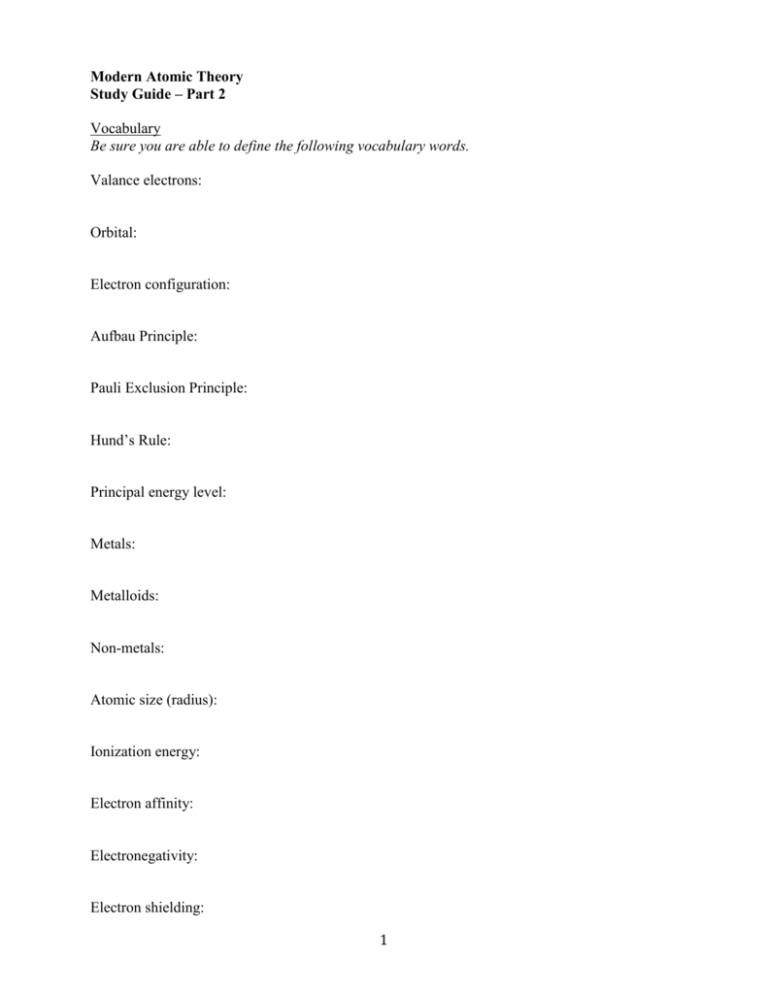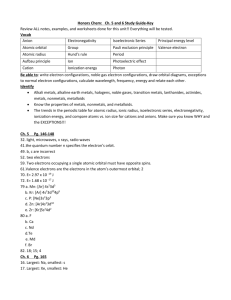Study guide part 2
advertisement

Modern Atomic Theory Study Guide – Part 2 Vocabulary Be sure you are able to define the following vocabulary words. Valance electrons: Orbital: Electron configuration: Aufbau Principle: Pauli Exclusion Principle: Hund’s Rule: Principal energy level: Metals: Metalloids: Non-metals: Atomic size (radius): Ionization energy: Electron affinity: Electronegativity: Electron shielding: 1 Electron Configurations 1. Fill in the following table about the different types of orbitals. Orbital sublevel s orbital Number of orbital types Maximum # of electrons orbital can hold Location on the periodic table p orbital d orbital f orbital 2. What are the three rules for filling in the orbitals for electron configurations? 3. Identify the following elements from their orbital (box) diagrams and list the number of unpaired electrons. a. 1s ( ) 2s ( ) 2p ( )( )( ) 3s ( ) 3p ( )( )( ) 4s ( ) 3d ( )( )( )( )( ) b. 1s ( ) 2s ( ) 2p ( )( )( ) 3s ( ) 3p ( )( )( ) 4s ( ) 3d ( )( )( )( )( ) c. 1s ( ) 2s ( ) 2p ( )( )( ) 3s ( ) 3p ( )( )( ) 4s ( ) 3d ( )( )( )( )( ) d. 1s ( ) 2s ( ) 2p ( )( )( ) 3s ( ) 3p ( )( )( ) 4s ( ) 3d ( )( )( )( )( ) 2 4. What is a valence electron? How many maximum valence electrons can an atom hold in each period? 5. Write the full electron configuration for the following elements and circle the valence electrons. Element Atomic number Electron configuration Full Noble gas shorthand Be 6 1s22s22p4 F 10 1s22s22p63s23p2 Cl 19 1s22s22p63s23p64s23d5 Xe 85 6. Indicate if the following electron configurations are possible or not. If it is possible, identify the atom. If not, explain why. a. b. c. d. e. f. g. 1s22s22p3 1s22s22p63s23p5 1s22s22p103s23p1 1s22s22p63s23p64s23d5 [Kr]5s24d7 [[Ne]3s23d103p3 [Rn]7s25f6 3 Periodic Trends 7. Fill in the table below with the number of valence electrons for each of the 8 groups on the periodic table. Group Number Group name # of valence electrons I II III IV V VI VII VIII Alkali metals 1 Electron configuration of valence orbital ONLY (n) s1 --------- 8. Be able to describe and explain the following periodic trends: a. Atomic radius b. Ionization energy c. Electron affinity d. Electronegativity 9. Use the following sets of elements to complete the questions below. i. Ba, Ca, Ra ii. P, Si, Al iii. Rb, Cs, K a. List the 3 elements in order from the largest to the smallest atomic radius. i. ii. iii. b. List the 3 elements in order from the highest to lowest ionization energies. i. ii. iii. 4 Metal, metalloid or non-metal metal




